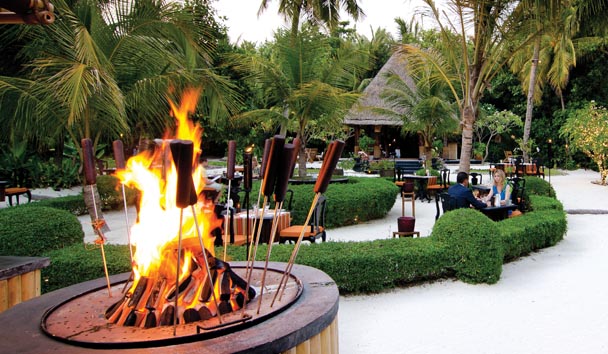Loading Maldives Offers....
BIGGER villas, even larger swimming pools, yet even more luxurious spas: on the Maldives, resorts are in a constant battle trying to outdo each other with attractions to lure tourists. And the latest battleground in this competition is in the kitchen.
Resorts are discovering that a way to a traveller’s heart is through his or her palate, and they are even bringing in star chefs from abroad to thrill their guests.
The days when tourists were simply satisfied with some fried fish at the beach are over. And a resort can no longer make do with just a single restaurant. “There must be at least two or three,” says French cook Jerome Voltat. “Otherwise the guests get bored.”
Voltat cooks at the One & Only resort on the island of Reethi Rah, and it has established itself as one of the top culinary spots in the Indian Oceaan. The resort has six restaurants spread across the island, each with its own cuisine and ambience.
The main restaurant has an elegantly-designed area serving international and Asian dishes as well as an outside terrace that combines with Mediterranean cuisines.
A further spot is the Japanese restaurant Tapasake built atop stilts out in a lagoon. While in such a paradise-like location even junk food would taste great, Tapasake serves up the best-quality sushi and wagyu beef dishes.
At the Anantara Kihava resort there is even an underwater restaurant with its own drink storage, the first such underwater storage on the Maldives. But in fact, other resorts also have underwater restaurants, led by the Conrad Rangali resort and its Ithaa restaurant. The largest underwater restaurant is the Hurawalhi.
But the battle of Maldives eateries is not just on land and sea. They are also going up in the air: the Niyama restaurant is the first one up in a tree. Guests sit on platforms built into the majestic crown of the tree while waiters carefully make their way across narrow bridges, balancing trays of Asian avant-garde dishes.
So restaurants on the Maldives are becoming increasingly unusual and the meals they serve of a much greater variety. And with better-trained cooks. The top resorts have been forced into a battle of the kitchens to keep up – not just because visitors have more sophisticated wishes, but are also more international. If originally the Maldives was the spot for Europeans, in the meantime visitors from other regions have become guests. From Asia, they include Koreans, Japanese, and increasingly, Chinese. Arab guests are also found more frequently in the luxury resorts.
Slowly, however, even local cuisine is making its way onto the menus of the top restaurants. This is no easy trick, given that on the tiny islands not much other than papayas, bananas and coconut palms are found. The sea offers a sheer infinite variety of fish, of course, but until now this had not been put to good use.
Maldives cuisine actually shows a mixture of Indian, Sri Lankan and Arabic influences. Fish is mostly grilled until very dry, while tuna fish is often drowned in curry sauce. Side dishes are usually rice or the traditional roshi, a thin pita bread. For Western palates, the local cuisine can sometimes be either too spicy or too bland.
In many resorts the cooks try to adapt local cuisine to the tastes of guests, something which does not always work as well as it does at the Park Hyatte Hadahaa in the southern Maldives. The resort offers genuine “family meals” in which a Maldive employee sits with the guests and explains to them how the dishes are prepared and how best to eat them.
Now, the Milaidhoo, a new resort in the north, has raised Maldivian cuisine to a higher level. On the luxury island of Baa-Atoll the TV cook Ahmed Sivath is in the kitchen. The star cook is out to re-interpret traditional dishes and present them in a gourmet style.
Subscribe to:
Post Comments (Atom)











No comments:
Post a Comment